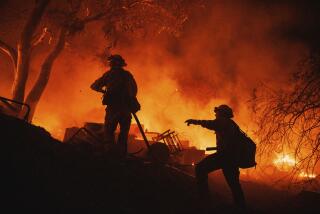Waldo Canyon is latest super fire; get used to them, expert says
So-called super fires -- like the fire currently rampaging through the Colorado Springs area, spurring mass evacuations, destroying property and endangering lives -- are not going away.
They will continue to flare up, not just around the U.S. but also around the world and, possibly, become more severe, one expert says.
Peter Fulé, a longtime professor in the school of forestry at Northern Arizona University in Flagstaff, talked to the Los Angeles Times on Wednesday about the “perfect confluence” of factors fueling fires such as Colorado’s Waldo Canyon fire.
That fire spurred authorities to order the evacuation of 32,000 people early Wednesday, as winds up to 60 mph whipped flames across extremely dry terrain.
The blaze is an example of a “crown fire,” Fulé said, which spreads -- often at great speed -- through treetops.
In this type of fire, “the fire is burning through the entire tree. The tree is 80 or 90 feet tall, and flames are even higher than that. Firefighters can’t even get close to them,” he said. Such conditions, when combined with the winds, can hamper aerial firefighting efforts. “It’s a very severe type of fire, an intense type of burning.”
Super fires aren’t new, of course.
There are parts of the world and the western U.S. in particular where huge, infrequent fires are part of the natural fire ecology, Fulé said. But that isn’t the case for some areas now falling prey to super fires.
The reason? Modern firefighting technology has meant fewer fires. Fuel to feed massive blazes has built up. And, Fulé said, climate change has brought warming conditions over the last couple of decades -- meaning longer fire seasons, starting early in the spring and extending late into the fall.
Even if rain and snow amounts remain the same, he said, warmer temperatures mean more evaporation, drying out the landscape. Individual drought years increase the risk of huge fires: “This winter in Colorado, it was quite dry.”
And the future looks only drier and warmer.
“The predictions climatologists are developing for the 21st century don’t look any better,” Fulé said. With plentiful fuel and warming conditions, super fires likely will continue to ignite.
The fallout will include “loss of life, loss of homes and communities and infrastructure,” as well as long-term effects such as soil erosion, flooding, and the invasion of exotic plant species with the death of native species.
But Fulé isn’t ready to suggest a doomsday scenario.
There are things that can be done -- and are being done -- to combat this fiery future.
Thinning smaller, younger trees from forests and using proscribed burning can greatly reduce the chance of a super fire. “Those are two important forest restoration techniques that are being done around the U.S.,” to some extent, he said.
The problem is, such efforts are expensive -- several hundred dollars to $1,000 per acre -- and there are millions of acres. The U.S. government manages most of the nation’s forest lands, he said, “and the federal government really doesn’t have a lot of extra money it doesn’t know what to do with.”
Still, efforts are being made. In Arizona, the Four Forests Restoration Initiative (4FRI) has embarked on a 20-year project that will make “a very large swath of central Arizona” -- about 2 million acres -- more resistant to super fires.
“There’s no panacea,” Fulé said. But there is “very strong evidence” that restoration treatments substantially reduce the chance of those areas burning with high severity.
“Even treating a portion of a landscape -- not necessarily 100% of a 2 million-acre national forest but perhaps 25%, 30% [or] 40% also makes a big difference,” helping to break up the sweep of a super fire.
ALSO:
Colorado wildfires rage out of control amid triple-digit heat
Marina Keegan: Yale graduate’s boyfriend faces charges in crash
Jerry Sandusky letter to abuse victim: ‘There has been love in my heart’
Join Amy on Google+. Email: amy.hubbard@latimes.com
More to Read
Start your day right
Sign up for Essential California for news, features and recommendations from the L.A. Times and beyond in your inbox six days a week.
You may occasionally receive promotional content from the Los Angeles Times.







